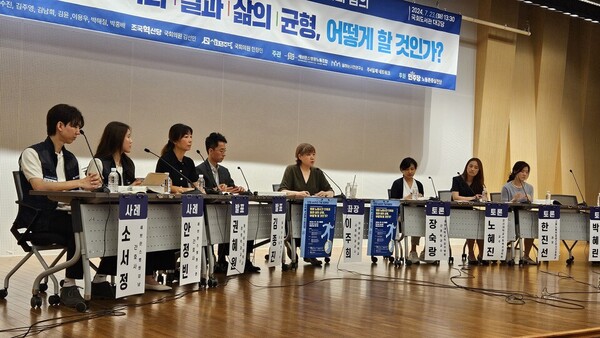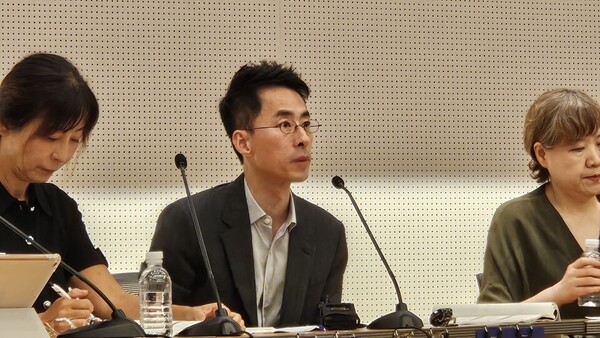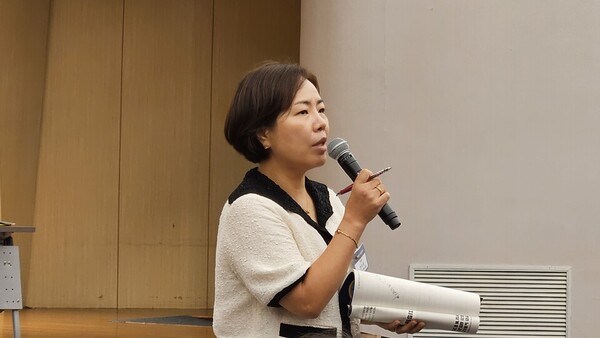S. KOREA
4-day workweek reduced turnover and increased quality: Severance Hospital
기자명 Kim Ju-yeon
Published 2024.07.24
Copy url(으)로 기사보내기 이메일(으)로 기사보내기 다른 공유 찾기 기사스크랩하기
Yonsei University Health System’s “four-day workweek experiment,” the first of its kind among medical institutions, has produced positive results in reducing nurse turnover and increasing job satisfaction.
However, there were many obstacles to overcome, including securing the financial resources needed to hire more staff, before the program could be established as a system rather than a pilot project, according to the hospital group’s labor union.
Yonsei University Health System’s “four-day workweek experiment,” the first of its kind among medical institutions, has produced positive results in reducing nurse turnover and increasing job satisfaction.
However, there were many obstacles to overcome, including securing the financial resources needed to hire more staff, before the program could be established as a system rather than a pilot project, according to the hospital group’s labor union.

On Tuesday, the Severance Hospital Labor Union held a briefing session on “Results and Implications of the One-Year Four-Day Workweek Pilot Project at the National Assembly Library. (KBR photo)
On Tuesday, the Severance Hospital Labor Union held a briefing session on “Results and Implications of the Four-Day Workweek Pilot Project” at the National Assembly Library. It was the second report after the interim report session on Oct. 11 last year when the union released the interim results of the four-day workweek pilot project.
The labor and management of Severance Hospital agreed on Aug. 8, 2022, to implement a four-day week pilot project for one year from January to December 2023, divided into the first and second halves, through a collective agreement. Last year, five nurses were selected from Wards 171-172 of Severance Hospital and Ward 83 of Gangnam Severance Hospital, with 30 nurses participating in the four-day pilot project.
By agreeing to extend the four-day workweek pilot project by one year and expand the participating wards this year, the project is in its second year.
At the briefing, the survey results conducted on 30 nurses who participated in the pilot project last year were revealed.
On Tuesday, the Severance Hospital Labor Union held a briefing session on “Results and Implications of the Four-Day Workweek Pilot Project” at the National Assembly Library. It was the second report after the interim report session on Oct. 11 last year when the union released the interim results of the four-day workweek pilot project.
The labor and management of Severance Hospital agreed on Aug. 8, 2022, to implement a four-day week pilot project for one year from January to December 2023, divided into the first and second halves, through a collective agreement. Last year, five nurses were selected from Wards 171-172 of Severance Hospital and Ward 83 of Gangnam Severance Hospital, with 30 nurses participating in the four-day pilot project.
By agreeing to extend the four-day workweek pilot project by one year and expand the participating wards this year, the project is in its second year.
At the briefing, the survey results conducted on 30 nurses who participated in the pilot project last year were revealed.

Kim Jong-jin, head of the Korea Worker Institute-Union Center, who participated in the research, explained the results of the four-day workweek pilot project in 2023. (KBR photo)
Kim Jong-jin, head of the Korea Worker Institute-Union Center, who participated in the research, said that the nurses who participated in the four-day workweek pilot project experienced increased job satisfaction, leading to a reduced turnover rate and improved quality of nursing services.
According to the study, the turnover rate in the wards that implemented the four-day week has decreased significantly compared to 2022. In 2022, Ward 171 had a turnover rate of 3.6 percent, which fell to 0 percent in 2023. Ward 172 also saw its turnover rate drop to 2.6 percent. At Ward 83, the rate decreased from 27.0 percent in 2022 to 18.2 percent in 2023.
The number of kindnesses rated by patients also increased. Ward 171 increased from 85 kind services in 2022 to 132 in 2023, and Ward 172 increased from 42 to 111. However, Ward 83 marked a decrease from 74 to 70 acts of kindness. At Wards 141 and 81, the number of acts of kindness increased from 80 to 93 and from 39 to 46, too, but the increase was greater on units with a four-day week.
Nurses on the four-day week felt that the quality of care was improving.
When comparing the results of the first survey, conducted in December 2022 before the pilot began, to the fourth survey, conducted in December 2023 after the pilot was completed in the second half of the year, the score for the item “The risk of medical and safety incidents is increasing” decreased from 69.6 in the first survey to 59.3 in the fourth survey. For the item “Friendliness toward users is increasing,” the score increased from 55.2 in the first round to 60.2 in the fourth round. For the item “The quality of medical and counseling services provided to users is improving,” the score increased from 56.7 in the first round to 63.8 in the fourth round, an increase of 7.1 points.
They reported a significant increase in job satisfaction and a turnover intention decrease. On a 100-point job satisfaction scale, the highest score for four-day workers was 65.2, while the highest score for five-day workers was 52.7, a difference of 12.5 points. And while only 18.7 percent of four-day workers would consider changing jobs, the number jumped to 68.2 percent of five-day workers.
The increased number of days off also improved nurses' health.
When asked about absenteeism when an employee misses work due to sick leave or other reasons, the absenteeism rate dropped from 10.0% in the first survey to 8.3 percent in the fourth survey. Presenteeism, which refers to coming to work while sick and being less productive, also dropped from 86.4 percent in the first survey to 68.2 percent in the fourth.
Besides, the percentage of nurses working four days a week who suffered from sleep disorders, depression, musculoskeletal disorders, disks, cystitis, plantar fasciitis, and other related conditions also decreased.
Kim emphasized that a four-day workweek can reduce unnecessary costs.
“We need to institutionalize pilot projects, such as the four-day workweek, to improve the health, work-life balance, job satisfaction, and turnover of hospital nurses,” Kim said. “If the turnover rate of new nurses decreases, the cost of investing in education and training will also decrease. It also reduces unemployment benefits. This will improve nurses' work-life balance and reduce social and economic costs.”
“Based on Articles 11 and 4 of the Healthcare Workforce Support Act, the government must support efforts to secure adequate working hours and improve working conditions. As there is a provision for this, relevant government ministries should take steps to expand the four-day week pilot project,” he added.
Kim Jong-jin, head of the Korea Worker Institute-Union Center, who participated in the research, said that the nurses who participated in the four-day workweek pilot project experienced increased job satisfaction, leading to a reduced turnover rate and improved quality of nursing services.
According to the study, the turnover rate in the wards that implemented the four-day week has decreased significantly compared to 2022. In 2022, Ward 171 had a turnover rate of 3.6 percent, which fell to 0 percent in 2023. Ward 172 also saw its turnover rate drop to 2.6 percent. At Ward 83, the rate decreased from 27.0 percent in 2022 to 18.2 percent in 2023.
The number of kindnesses rated by patients also increased. Ward 171 increased from 85 kind services in 2022 to 132 in 2023, and Ward 172 increased from 42 to 111. However, Ward 83 marked a decrease from 74 to 70 acts of kindness. At Wards 141 and 81, the number of acts of kindness increased from 80 to 93 and from 39 to 46, too, but the increase was greater on units with a four-day week.
Nurses on the four-day week felt that the quality of care was improving.
When comparing the results of the first survey, conducted in December 2022 before the pilot began, to the fourth survey, conducted in December 2023 after the pilot was completed in the second half of the year, the score for the item “The risk of medical and safety incidents is increasing” decreased from 69.6 in the first survey to 59.3 in the fourth survey. For the item “Friendliness toward users is increasing,” the score increased from 55.2 in the first round to 60.2 in the fourth round. For the item “The quality of medical and counseling services provided to users is improving,” the score increased from 56.7 in the first round to 63.8 in the fourth round, an increase of 7.1 points.
They reported a significant increase in job satisfaction and a turnover intention decrease. On a 100-point job satisfaction scale, the highest score for four-day workers was 65.2, while the highest score for five-day workers was 52.7, a difference of 12.5 points. And while only 18.7 percent of four-day workers would consider changing jobs, the number jumped to 68.2 percent of five-day workers.
The increased number of days off also improved nurses' health.
When asked about absenteeism when an employee misses work due to sick leave or other reasons, the absenteeism rate dropped from 10.0% in the first survey to 8.3 percent in the fourth survey. Presenteeism, which refers to coming to work while sick and being less productive, also dropped from 86.4 percent in the first survey to 68.2 percent in the fourth.
Besides, the percentage of nurses working four days a week who suffered from sleep disorders, depression, musculoskeletal disorders, disks, cystitis, plantar fasciitis, and other related conditions also decreased.
Kim emphasized that a four-day workweek can reduce unnecessary costs.
“We need to institutionalize pilot projects, such as the four-day workweek, to improve the health, work-life balance, job satisfaction, and turnover of hospital nurses,” Kim said. “If the turnover rate of new nurses decreases, the cost of investing in education and training will also decrease. It also reduces unemployment benefits. This will improve nurses' work-life balance and reduce social and economic costs.”
“Based on Articles 11 and 4 of the Healthcare Workforce Support Act, the government must support efforts to secure adequate working hours and improve working conditions. As there is a provision for this, relevant government ministries should take steps to expand the four-day week pilot project,” he added.

Kwon Mi-kyung, leader of the Severance Hospital Labor Union, said she will work to expand the four-day workweek pilot project to other hospitals. (KBR photo)
Professor Jang Soong-nang of Chung-Ang University College of Nursing, who also participated in the panel, advised on what other hospitals should consider when implementing a four-day week pilot project.
“For the management, money is bound to be a priority as implementing a four-day workweek requires staff recruitment,” Professor Jang said. “In addition, there may be concerns that patient care may be neglected as working hours are reduced.”
“We need to study the necessity of a four-day workweek by thoroughly analyzing current issues and overseas cases,” she said. “We also need to review legal regulations, including whether a new law is needed to implement a four-day workweek. It is also recommended to organize evidence to refute concerns that the four-day workweek may cause costs due to the division of duties among nurses and scheduling.”
Severance Hospital Labor Union leader Kwon Mi-kyung said, “The medical center is still skeptical about the manpower and effectiveness of the four-day week pilot project. However, the labor and management decided to conduct the pilot project because they agreed it would reduce nurses’ turnover.”
“I know that other unions are concerned about wage cuts, but we agreed to a 10 percent cut in our existing wages because it could be misunderstood as a favoritism compared to other employees,” Kwon said. “The union's goal is a four-day workweek without wage cuts and we will work to expand it to all Severance Hospital employees and other hospitals, and to get the government's attention.”
Professor Jang Soong-nang of Chung-Ang University College of Nursing, who also participated in the panel, advised on what other hospitals should consider when implementing a four-day week pilot project.
“For the management, money is bound to be a priority as implementing a four-day workweek requires staff recruitment,” Professor Jang said. “In addition, there may be concerns that patient care may be neglected as working hours are reduced.”
“We need to study the necessity of a four-day workweek by thoroughly analyzing current issues and overseas cases,” she said. “We also need to review legal regulations, including whether a new law is needed to implement a four-day workweek. It is also recommended to organize evidence to refute concerns that the four-day workweek may cause costs due to the division of duties among nurses and scheduling.”
Severance Hospital Labor Union leader Kwon Mi-kyung said, “The medical center is still skeptical about the manpower and effectiveness of the four-day week pilot project. However, the labor and management decided to conduct the pilot project because they agreed it would reduce nurses’ turnover.”
“I know that other unions are concerned about wage cuts, but we agreed to a 10 percent cut in our existing wages because it could be misunderstood as a favoritism compared to other employees,” Kwon said. “The union's goal is a four-day workweek without wage cuts and we will work to expand it to all Severance Hospital employees and other hospitals, and to get the government's attention.”

Park Hye-rin, director of the Nursing Policy Division at the Ministry of Health and Welfare, said specific performance indicators for the four-day week pilot program are needed to demand the government’s support. (KBR photo)
The government said that the pilot program needs to show objective indicators improving employee satisfaction and patient health to demand the government’s support for its expansion.
“We need concrete data to support this, not just subjective results that participants’ remarks that they could provide better services,” said Park Hye-rin, head of the Nursing Policy Division at the Ministry of Health and Welfare. “Developing concrete indicators, such as the number of patient safety incidents and the extent to which patients’ medical expenses were reduced after the pilot project, will help the government expand and implement the pilot project.”
“The government supports the expansion of manpower for the pilot project to improve the nurse shift system. However, a four-day workweek is impossible with the labor costs supported by the shift system pilot project,” she said. “Health insurance is a financial source for supporting people's health, so we need to accumulate indicators that prove it helps people's health.”
The government said that the pilot program needs to show objective indicators improving employee satisfaction and patient health to demand the government’s support for its expansion.
“We need concrete data to support this, not just subjective results that participants’ remarks that they could provide better services,” said Park Hye-rin, head of the Nursing Policy Division at the Ministry of Health and Welfare. “Developing concrete indicators, such as the number of patient safety incidents and the extent to which patients’ medical expenses were reduced after the pilot project, will help the government expand and implement the pilot project.”
“The government supports the expansion of manpower for the pilot project to improve the nurse shift system. However, a four-day workweek is impossible with the labor costs supported by the shift system pilot project,” she said. “Health insurance is a financial source for supporting people's health, so we need to accumulate indicators that prove it helps people's health.”
 |
| 1933 |
No comments:
Post a Comment